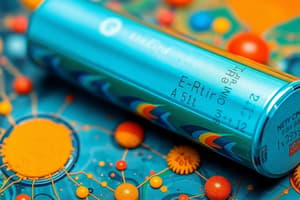Podcast
Questions and Answers
What is the primary method of energy storage in conventional capacitors?
What is the primary method of energy storage in conventional capacitors?
- Using redox reactions
- Chemical bonds in electrolytic solutions
- Electrostatic storage at electrode surfaces (correct)
- Magnetic fields between plates
Which factor does NOT affect the capacitance of a capacitor?
Which factor does NOT affect the capacitance of a capacitor?
- Plate area
- Voltage applied (correct)
- Distance between plates
- Properties of the medium between plates
What differentiates a supercapacitor from a traditional capacitor?
What differentiates a supercapacitor from a traditional capacitor?
- Use of low surface area electrodes
- Incorporation of electrolytic solutions instead of dielectrics (correct)
- Storage of energy through chemical reactions
- Larger physical size only
In supercapacitors, what role do the electrolyte ions play when charged?
In supercapacitors, what role do the electrolyte ions play when charged?
Which unit is used to express capacitance?
Which unit is used to express capacitance?
What is a key advantage of supercapacitors compared to batteries?
What is a key advantage of supercapacitors compared to batteries?
The capacitance of a capacitor is directly proportional to which of the following?
The capacitance of a capacitor is directly proportional to which of the following?
Which material is mentioned as having an εr value of 7 in the context of capacitors?
Which material is mentioned as having an εr value of 7 in the context of capacitors?
What limits the capacity of a traditional capacitor compared to a supercapacitor?
What limits the capacity of a traditional capacitor compared to a supercapacitor?
When calculating the energy stored in a capacitor, what parameters are critical?
When calculating the energy stored in a capacitor, what parameters are critical?
What is the primary reason supercapacitors can be charged and discharged quickly compared to batteries?
What is the primary reason supercapacitors can be charged and discharged quickly compared to batteries?
Which aspect limits the voltage that can be applied to aqueous electrolytes in supercapacitors?
Which aspect limits the voltage that can be applied to aqueous electrolytes in supercapacitors?
What formula is used to calculate the energy stored in a supercapacitor?
What formula is used to calculate the energy stored in a supercapacitor?
Compared to batteries, supercapacitors generally store energy per unit weight that is:
Compared to batteries, supercapacitors generally store energy per unit weight that is:
How does the energy stored in a 1.1 F supercapacitor at 1.0 V compare to a 310 pF capacitor at 5.0 V?
How does the energy stored in a 1.1 F supercapacitor at 1.0 V compare to a 310 pF capacitor at 5.0 V?
What is a typical maximum charging/discharging cycle count for supercapacitors?
What is a typical maximum charging/discharging cycle count for supercapacitors?
In terms of power delivery, supercapacitors are considered to be:
In terms of power delivery, supercapacitors are considered to be:
What factor primarily determines how much energy can be stored in a supercapacitor?
What factor primarily determines how much energy can be stored in a supercapacitor?
What characteristic of supercapacitors makes them unsuitable for long-term energy storage compared to batteries?
What characteristic of supercapacitors makes them unsuitable for long-term energy storage compared to batteries?
Which of the following options best describes the relationship between energy, capacitance, and voltage in supercapacitors?
Which of the following options best describes the relationship between energy, capacitance, and voltage in supercapacitors?
Flashcards
Capacitors
Capacitors
Devices that store electrical energy electrostatically, at the surface of electrodes. Unlike batteries, they do not utilize redox reactions.
Capacitance (C)
Capacitance (C)
The ability of a capacitor to store charge. It's measured in Farads (F) and tells us how much charge (Coulombs, C) is stored per unit voltage (Volts, V).
Plate Separation (d)
Plate Separation (d)
The distance between the plates of a capacitor. It plays a crucial role in determining the capacitance.
Plate Area (A)
Plate Area (A)
Signup and view all the flashcards
Dielectric Material
Dielectric Material
Signup and view all the flashcards
Dielectric Constant (εr)
Dielectric Constant (εr)
Signup and view all the flashcards
Supercapacitors
Supercapacitors
Signup and view all the flashcards
Electrolyte
Electrolyte
Signup and view all the flashcards
Ion Adsorption
Ion Adsorption
Signup and view all the flashcards
High Surface Area Electrodes
High Surface Area Electrodes
Signup and view all the flashcards
Voltage changes in supercapacitors
Voltage changes in supercapacitors
Signup and view all the flashcards
Energy storage in supercapacitors
Energy storage in supercapacitors
Signup and view all the flashcards
Electrolyte stability limits voltage
Electrolyte stability limits voltage
Signup and view all the flashcards
Voltage limit of aqueous electrolytes
Voltage limit of aqueous electrolytes
Signup and view all the flashcards
Long lifespan of supercapacitors
Long lifespan of supercapacitors
Signup and view all the flashcards
Supercapacitor energy density
Supercapacitor energy density
Signup and view all the flashcards
High power of supercapacitors
High power of supercapacitors
Signup and view all the flashcards
Ragone plot
Ragone plot
Signup and view all the flashcards
Applications of supercapacitors
Applications of supercapacitors
Signup and view all the flashcards
Role of electrolytes in supercapacitors
Role of electrolytes in supercapacitors
Signup and view all the flashcards
Study Notes
Supercapacitors
- Supercapacitors store electrical energy electrostatically, unlike batteries which use redox reactions.
- They use very large electrodes and electrolytic solutions which greatly increases their capacitance.
- Capacitance (C) is measured in farads (F) and relates the amount of charge stored to the voltage across the plates.
- C is affected by plate area(A), the distance between plates (d) and the permittivity of the medium between them.
Capacitors
- Capacitors store electrical energy electrostatically on the surface of electrodes.
- The capacitance (C) is proportional to the area of the plates and inversely proportional to the distance between them.
- C = ε₀εᵣA/d , where ε₀ is the permittivity of free space, εᵣ is the relative permittivity of the dielectric material, A is the area of the plates, and d is the distance between them.
- Capacitors contain a dielectric material (insulator) between the plates.
Supercapacitors vs. Capacitors
- Supercapacitors use an electrolyte instead of a dielectric, making the distance between the plates very small.
- This allows supercapacitors to store significantly more charge than conventional capacitors.
High Surface Area Electrodes
- High surface area electrodes are used in supercapacitors to maximize the stored charge.
- Materials like activated carbons and carbon nanotubes have exceptionally high surface areas (up to 2000 m²/g).
Electrolytes in Supercapacitors
- Electrolytes are essential for supercapacitors.
- When a charged electrode surface is in an electrolyte solution, ions adsorb onto the electrode.
- For a positive electrode, anions adsorb; for a negative electrode, cations adsorb.
Supercapacitor Structure
- Supercapacitors consist of two electrodes separated by an electrolyte and a separator.
- When charged, electrolyte ions adsorb onto the high surface-area electrodes..
Supercapacitor Capacitance
- Capacitance (in a series of capacitors) is influenced by the individual electrode capacitances
- The capacitance of a device is primarily determined by the electrode with the smallest capacitance
Charging/Discharging Supercapacitors
- Charging/discharging supercapacitors is a fast process, unlike in batteries.
- The voltage of a supercapacitor increases and decreases as charge is added or removed.
- Charging/Discharging speed is faster than in batteries due to absence of electrochemical reactions
Supercapacitor Energy Storage
- Energy (E) stored in a supercapacitor is given by 1/2 CV².
- The voltage (V) limit, in aqueous electrolytes, is about 1 V.
Supercapacitor Applications
- Supercapacitors are used in various applications where short bursts of energy are needed, such as doors on airplanes, power back-ups, in mobile device memory functions, in actuators of digital cameras, regenerative braking systems, and in power-delivery systems.
Supercapacitor Lifetime
- Supercapacitors have a much longer lifespan than batteries.
- They can be charged and discharged many times – potentially up to 10⁶ cycles.
Supercapacitors Compared to Other Energy Storage Devices
- Supercapacitors store less energy per unit weight compared to batteries.
- Supercapacitors are higher-power devices than batteries; they release energy faster.
- This trade-off is illustrated by Ragone plot.
Studying That Suits You
Use AI to generate personalized quizzes and flashcards to suit your learning preferences.




